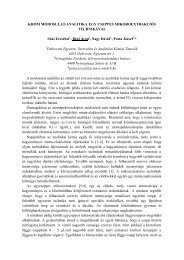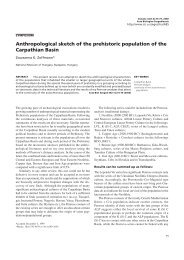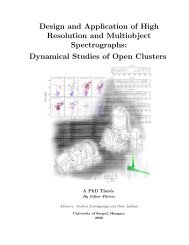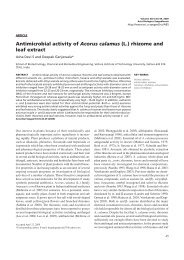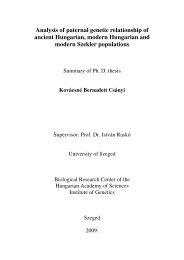principles of extraction and the extraction of semivolatile organics ...
principles of extraction and the extraction of semivolatile organics ...
principles of extraction and the extraction of semivolatile organics ...
You also want an ePaper? Increase the reach of your titles
YUMPU automatically turns print PDFs into web optimized ePapers that Google loves.
50 <strong>principles</strong> <strong>of</strong> <strong>extraction</strong><br />
<strong>the</strong> list <strong>of</strong> key chemical properties? In general, <strong>the</strong>re is a trend toward an<br />
inverse relationship between <strong>the</strong>se parameters such that high water solubility<br />
is generally accompanied by low hydrophobicity, <strong>and</strong> vice versa.<br />
Many authors use this relationship to estimate one <strong>of</strong> <strong>the</strong>se parameters from<br />
<strong>the</strong> o<strong>the</strong>r. However, it is this author’s opinion that <strong>the</strong> n-octanol/water partition<br />
coe‰cient <strong>and</strong> water solubility are not interchangeable (via inverse<br />
relationships) because <strong>the</strong>y measure di¤erent phenomena. Water solubility<br />
is a property measured at maximum capacity or saturation. The n-octanol/<br />
water partition coe‰cient measures distribution across an interface. While<br />
<strong>the</strong> relationship between water solubility <strong>and</strong> <strong>the</strong> n-octanol/water partition<br />
coe‰cient may be highly correlated for closely related families <strong>of</strong> congeners<br />
(Figure 2.5), as <strong>the</strong> diversity <strong>of</strong> <strong>the</strong> compounds compared increases, <strong>the</strong> correlation<br />
between <strong>the</strong>se two parameters decreases (Figure 2.6). However, solubility<br />
should remain on <strong>the</strong> list <strong>of</strong> essential chemical properties because if <strong>the</strong><br />
value <strong>of</strong> <strong>the</strong> octanol–water partition coe‰cient is unavailable, water solubility<br />
can be used as a surrogate. Also, solubility is used to estimate <strong>the</strong><br />
Henry’s law constant.<br />
2.1.3. Acid–Base Equilibria<br />
The acid–base character <strong>of</strong> a chemical <strong>and</strong> <strong>the</strong> pH <strong>of</strong> <strong>the</strong> aqueous phase<br />
determine <strong>the</strong> distribution <strong>of</strong> ionized–nonionized species in solution. Starting<br />
from <strong>the</strong> equilibrium dissociation <strong>of</strong> a weak acid, HA,<br />
HA Ð H þ þ A ð2:9Þ<br />
<strong>the</strong> equilibrium constant for dissociation <strong>of</strong> a weak acid can be written as<br />
Ka ¼ ½Hþ Š½A Š<br />
½HAŠ<br />
ð2:10Þ<br />
Analogously, <strong>the</strong> dissociation <strong>of</strong> <strong>the</strong> conjugate acid, BH þ , <strong>of</strong> a base, B, is<br />
described as<br />
<strong>and</strong> <strong>the</strong> related constant is<br />
BH þ Ð H þ þ B ð2:11Þ<br />
Ka ¼ ½HþŠ½BŠ ½BH þ ð2:12Þ<br />
Š<br />
Ionizable compounds’ Ka values (Figure 2.7) have an orders-<strong>of</strong>-magnitude










